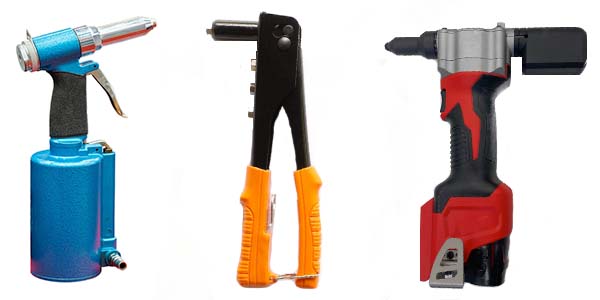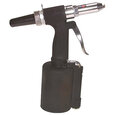Rivet Guns Overview

Figure 1: From left to right: pneumatic rivet gun, manual rivet gun, and an electric rivet gun
Rivet guns use pressure to apply rivets which fasten two work pieces together. They're common in mechanical engineering and the construction industries. As seen in Figure 1, there are various types of rivet guns, each having its pros and cons. It is necessary to know the features of each rivet gun type to select the best one for a particular application. This article discusses what a rivet gun is, how it works, its different types, and its applications. Read our rivet gun guide for more details on how to use a rivet gun.
Table of contents
- What is riveting?
- What is a rivet gun?
- Rivet gun types
- Rivet gun selection
- Rivet gun issues
- Rivet gun maintenance
- FAQs
View our online selection of pneumatic rivet guns!
What is riveting?
Riveting is a process used to join two pieces of metal using rivets. Rivets are small cylindrical pins that come in various sizes, materials, and shapes. The riveting process involves pushing a rivet through a hole drilled in a material. The rivet’s tail is then buckled or screwed so that it protrudes to approximately 1.5 times the shaft diameter, holding the rivet in place. With proper use, riveting can be an effective way to make strong and durable joints that do not require welding or brazing.
Different industries and applications use rivets, including the aerospace and automotive industries. Also, construction projects, such as scaffolding or framework building, often require riveting. Read our article on riveting for more details on the riveting process.
What is a rivet gun?
A rivet gun is a simple tool to fasten two or more pieces of metal together. The operator inserts the rivets into the barrel by hand or with an automatic feeder device that moves them into place. The rivet gun is ready to use once a rivet is fed into the barrel.
Rivet gun types
Rivet guns come in different types. For example, a larger rivet gun is necessary to connect pieces of wood than the rivet gun needed to create a decorative design on a piece of furniture.
A comparison of the different types of rivet guns is given below.
Manual rivet gun
Manual rivet guns (seen in Figure 1 left) are operated by hand power alone. The operator holds the tool in one hand while pulling back on a lever with the other hand; this causes the barrel to advance while simultaneously driving the head of a rivet into place. Read our article on manual rivet tools for more details on the parts and operation of a manual rivet tool.
Features
- Lightweight
- Easy to use
- Available at reasonable prices
- Takes more time for riveting
- Stressful on hands and wrists if used repeatedly
Applications
Manual rivet guns are used for applications like assembling furniture pieces at home and repairing damaged equipment in the garage.
Electric rivet gun
An electric rivet gun (Figure 1 middle) is powered by a motor. It uses an internal spring mechanism to drive a piston, pushing the rivet through a hole and then out the back, where it's crushed against the opposite side of the joint. Read our article on electric rivet guns for more details on the parts and operation of an electric rivet gun.
Features
- Faster and more efficient way of assembling a project
- Electric rivet guns can drive multiple rivets simultaneously, unlike a manual rivet gun
- The cordless variant comes in handy with rechargeable batteries
- Expensive
Applications
Electric rivet guns are ideal for large-scale production or to make fast repairs on a car or truck.
Pneumatic rivet gun
Pneumatic rivet guns (Figure 1 right) are powered by compressed air instead of electricity. Pneumatic riveters use compressed air to move a piston, which operates the jaws of the air riveting tool, which in turn installs the rivet by pulling on the mandrel until it breaks off. Read our article on pneumatic rivet guns for more details on the operation, system parts, and types of pneumatic rivet guns.
Features
- Light-weight
- High-quality riveting
- Easy to use
Applications
Pneumatic rivet guns are ideal for small-scale work on various materials, and they're also great for people who need to make quick repairs. They're also much easier to use than electric models, meaning people with limited trade experience can use them.
Rivet gun selection
The necessary type of rivet gun depends on the applications, material, and rivet size.
- Materials: Use a manual or pneumatic rivet tool while working with softer materials such as wood or plastic. Electric rivet guns are suitable for heavy-duty uses where strength is needed more than speed (like steel). These tools are typically more powerful than manual or pneumatic rivet guns and are suitable for many strong materials.
- Ease of use: Manual rivet guns require significant pressure to use and leave the mandrel collection to the user. Electric and pneumatic rivet guns are easier to operate and some have provisions to catch the mandrels after riveting.
- Speed: Pneumatic rivet guns are the fastest at installing rivets, followed by their electric and manual counterparts, respectively.
- Power supply requirement: Electric rivet guns require a power supply to operate. Hence, choose a manual or pneumatic gun if there is no power outlet nearby.
- Portability: Pneumatic rivet guns require a hosed connection to compressed air. This makes them less versatile for use compared to manual and electric rivet guns.
- Number of rivets: Use pneumatic or electric rivet guns if the project requires installing a large number of rivets in less time.
- Rivet size: Use manual rivet guns for small, thin-walled tubing. Use an electric or pneumatic rivet gun to rivet larger tubes. These tools can handle larger diameters and thicker materials more efficiently than manual rivet guns.
Rivet gun issues
Some common issues that a user may encounter with a rivet gun include:
Jamming
A rivet can get jammed within a rivet gun. Use good-quality tools and materials to prevent rivet jamming. For example, avoid using cheap rivets that break easily when compressed.
Rivet gun doesn't work
The rivet gun may not be operating correctly due to misuse. It may also be that the rivet jams inside the tool. Try cleaning out any rivets that may have caught up in your machine, and then test it again. Also, check for any mechanical issues with the machine. Ensure that all the pieces are in place and not loose before using the rivet gun again. This could be as simple as replacing a filter or gasket, but it could also require replacing the entire machine.
Nozzle issues
If the nozzle isn't working correctly, it will cause problems with how quickly the rivet is pushed out of the gun. Adjust the tool settings to ensure everything is working in order.
Electrical issues
If you have an electrical issue with your rivet gun, you may have to hold the trigger down for longer than average, or it won't work. This could mean you need to replace a fuse or reset the circuit breaker on the machine.
Hydraulic oil leak
If a specific rivet gun requires hydraulic oil, the oil is necessary to keep the machine running. If you're experiencing a leak, tighten all of your fittings and check your oil level before using it again. Replace the gasket or seal if the leak is severe.
Rivet gun maintenance
Perform regular inspection and maintenance of a rivet gun to keep it running smoothly for a long time. Read our article on maintaining a pneumatic rivet gun for more information.
Inspecting rivet gun parts
- Trigger: The trigger is used to fire the rivet gun, so it must work smoothly to drive the rivets into place. Ensure there are no obstructions inside the trigger mechanism and it is properly lubricated before use.
- Handle: The rivet gun handle should be comfortable to hold and easy to grip, making it easier to use. If the handle feels loose or too tight, adjust the tension screw on the back of the gun until it feels right.
- Barrel: The barrel is used to hold the rivet, so it should be straight and free of any obstructions. Replace the barrel if it is bent or warped.
- Nosepiece: The nosepiece should be rounded and smooth, making it easy to drive in rivets without damaging them. If the nosepiece is chipped or broken, contact a gunsmith and have them replace it.
Cleaning the gun
It is essential to clean the gun after each use to prevent the formation of rust. This helps keep the device in good working condition and prolong its life.
Checking spring tension
Check the spring tension regularly to ensure it is not too tight or loose.
- A rivet gun with a loose spring will be less effective when driving a rivet, which could lead to unsafe situations when using your tool at high speeds.
- A rivet gun with a spring that is too tight could cause the device to break, which can even lead to an injury. Contact a professional for repairs if you notice any issues with your rivet gun's spring tension.
FAQs
How do you adjust a rivet gun?
For a manual rivet gun, you will need to move the handle back and forth until it reaches the desired tension. In some cases, adjusting the rivet gun may require loosening or tightening screws on the tool for it to work correctly again.
What is the most common use of an aluminum pop rivet gun?
The most common use of an aluminum pop rivet gun is to fasten pieces of metal together. You can use this tool for various applications, including aircraft construction and household repairs. Pop rivets are a fast and easy way to secure materials together. They are often used in construction projects, especially when building structures where you will be exposed to the elements.
What is the difference between a metallic and a plastic rivet gun?
A metallic rivet gun works with aluminum and steel materials. The tool has various attachments that allow you to work with different metals. Plastic pop rivets are often used in computer and telecommunications construction because they are lightweight and durable. You can also use them to attach plastic components.





